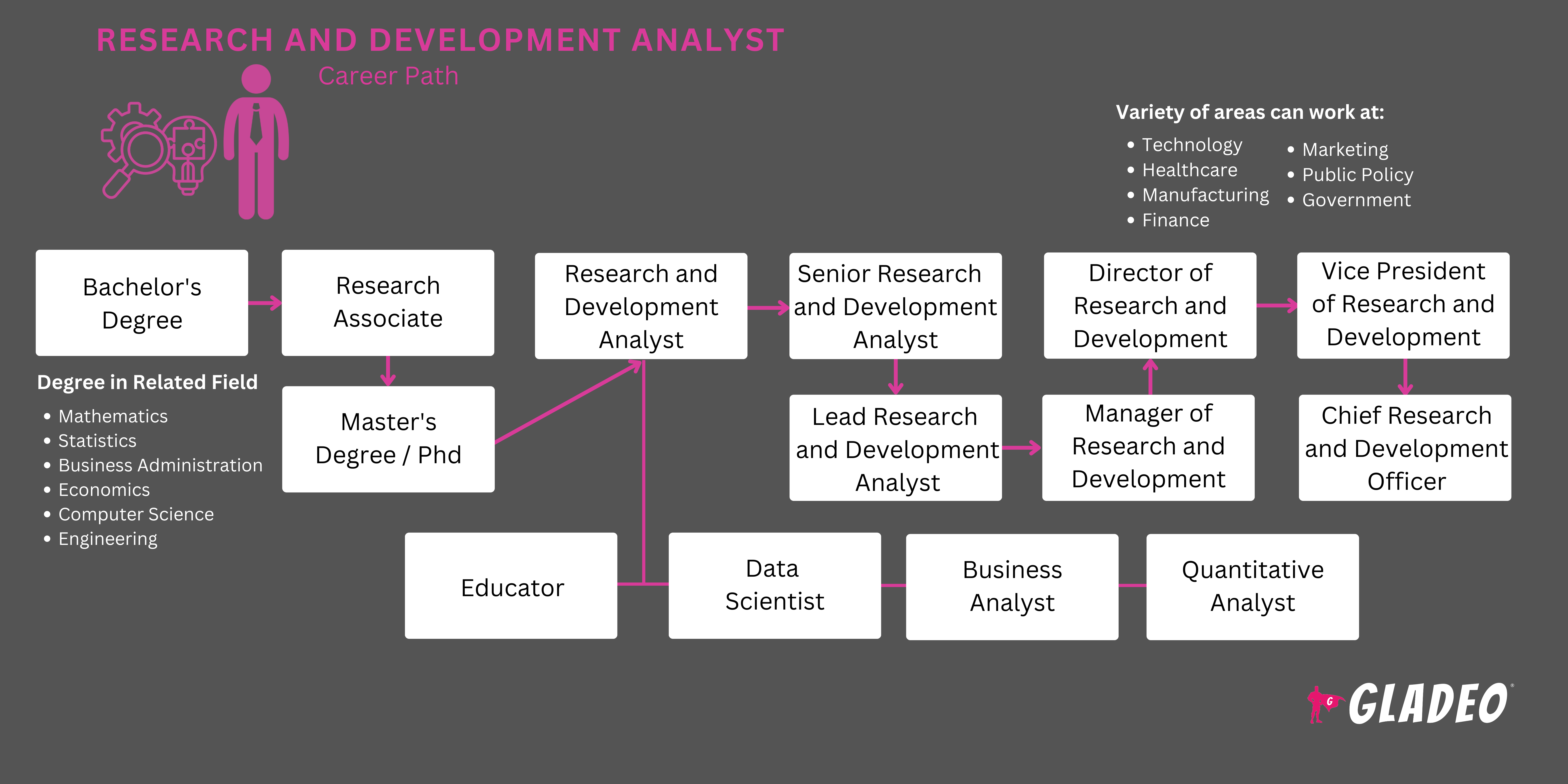Spotlights
Research and Development Scientist (R&D Scientist), Research And Development Scientist (R&D Scientist), Research And Development Coordinator (R&D Coordinator), Innovation Analyst, Technology Analyst, Product Research Analyst, Scientific Researcher, Market Research Analyst (with a focus on R&D-related topics), Innovation Strategist, Technology Development Analyst, Director of Research Development
Virtually every product ever created first went through a research and development (R&D) phase – the process of creating or improving products through scientific research and experimentation.
At the forefront of this innovative process are Research and Development Analysts, who help turn ideas into reality! They study the underlying principles of how things work and explore possibilities for new products or ways to enhance existing ones. In addition, they run experiments and analyze data from the results to determine the feasibility of a product.
Collaborating with scientists, engineers, and product managers, R&D Analysts help to ensure developments are cutting-edge, practical, and market-ready! The job requires a perfect mix of creativity and technical expertise along with a knack for critical thinking, problem-solving, and teamwork.
- Playing a key role in bringing innovative products to market
- Solving challenging problems and pushing technological boundaries
- Opportunities to work with the latest technologies and methodologies
- Collaborating with diverse teams of experts
Working Schedule
- Research and Development Analysts typically work full-time with occasional overtime or weekend shifts.
Typical Duties
- Review product concepts and conduct market analysis prior to development
- Research similar products, if found. Look for areas of improvement for existing products
- Research ways to develop new product ideas further and ascertain cost feasibility and potential consumer interest
- Collaborate with cross-functional teams to ensure project alignment
- Design and execute experiments to test hypotheses. Analyze data and interpret results
- Implement quality control procedures to meet standards
- Ensure regulatory compliance for new products and processes
- Monitor project progress, ensuring milestones are met
- Develop models and prototypes. Evaluate functionality, safety, and feasibility
- Prepare detailed reports to stakeholders. Share findings, gather feedback, and take applicable action, as directed
- Manage R&D project budgets and keep track of expenditures
- Draft technical documentation to support product use and maintenance
Additional Responsibilities
- Wear required personal protective equipment and follow safety protocols
- Stay up-to-date on technical manuals and new technologies
- Train and mentor junior staff
- Engage with suppliers and vendors for necessary resources
- Participate in conferences and workshops to gain insights and network
Soft Skills
- Analytical thinking
- Attention to detail
- Communication skills
- Problem-solving
- Teamwork
- Time management
- Observation
Technical Skills
- Computer-aided design software
- Familiarity with industry-specific tools and technologies
- Knowledge of statistical methods and experimental design
- Proficiency in data analysis software (e.g., SPSS, R, Python)
- Project management skills
- Technical writing skills for documenting research findings
- Automotive industry
- Consumer goods manufacturers
- Government agencies
- Pharmaceutical companies
- Research institutions
- Technology firms
Taking a concept and turning it into a marketable product is a daunting task, especially in a world where there is so much competition. But that’s what R&D Analysts get paid for! They help drive innovation and ensure new products get made and meet customer expectations.
The role demands a commitment to precision and accuracy, plus the ability to think creatively and solve problems that may arise. Tight schedules are par for the course – but there’s little room for mistakes, which means no taking shortcuts when time is getting short. Indeed, workers may have to put in overtime to meet target deadlines and stay within budget.
“In 2022, the United States performed an estimated $885.6 billion in research and development,” according to the National Center for Science and Engineering Statistics. That’s higher than the gross domestic product of 36 countries!
R&D investments will continue to ramp up as the field transforms with the help of AI and machine learning. These technologies aid with streamlining data analysis and predictive modeling, leading to faster, more cost-effective innovations.
Another trend is the use of digital twins, virtual models of physical systems, that allow precise simulation and optimization before creating physical prototypes. 3D printing, meanwhile, is revolutionizing rapid prototyping and complex design production, reducing waste and lowering costs.
Sustainability is another hot topic as companies invest in eco-friendly innovations and green technologies to meet regulations and consumer demand. A final trend in R&D is increased interdisciplinary collaboration, which aims to enhance open innovation and leverage wider knowledge and resources.
R&D Analysts often had a passion for science and exploration from a young age. They likely enjoyed conducting experiments, solving puzzles, and asking questions about how things work.
- Research and Development Analysts need at least a bachelor’s degree related to the field they work in, such as chemistry, engineering, computer science, mathematics, or physics
- A graduate degree can be beneficial but isn’t usually needed to get started in an entry-level position
- General college courses that are beneficial for R&D work include:
- Computer-aided design
- Data analysis
- Experimental design
- Industry-specific technologies
- Project management
- Statistical methods
- Technical writing
- Some employers provide on-the-job training or support for advanced certifications. Beneficial certifications may include:
- Look for well-funded programs with state-of-the-art labs and equipment where you can get practical hands-on training.
- Ideally, programs should have seasoned faculty members engaged in current research.
- Review opportunities for student internships and job placement rates for graduates.
- Compare tuition and fees costs, noting in-state vs. out-of-state costs.
- Check out scholarship and financial aid options, including federal aid Pell Grants
- STEM classes are important for anyone who wants to work in an R&D field
- Focus on areas that will apply to whatever you plan to major in and specialize in as an R&D Analyst
- For instance, if you want to work in the automotive industry, you’ll want to take automotive classes, study mechanical and electrical engineering, and learn how to use applicable design tools and software programs
- In addition to classes, it’s good to participate in science fairs and research projects
- Gain experience through part-time jobs or internships in the field you want to work in
- Join clubs or online communities related to STEM and R&D
- See what the top R&D companies and startups are doing these days!
- Build a portfolio of projects showcasing your attention to detail and problem-solving skills
- Start crafting your resume and add to it as you learn and gain work experience
- Review job postings in advance to see what the average requirements are
- Request to do an informational interview with working Research and Development Analysts. Try to speak with analysts in different fields. Ask if you can shadow them at work for a day
- Try to get a part-time job to get your foot in the door
- Make a list of your contacts (including email addresses or phone numbers) who might serve as future job references

- Check out job portals such as Indeed, Simply Hired, and Glassdoor
- Ask a working Research and Development Analyst for job-seeking tips
- Get help with your resume and interview skills from your school’s career center
- Talk to your college program manager about job placement opportunities
- Screen Research and Development Analyst resume templates for phrasing and formatting ideas
- Look up potential job interview questions and practice your responses via mock interviews. Sample questions might include:
- “Can you describe your experience with data analysis and statistical software?”
- “How do you stay updated with the latest advancements in your field?”
- “Can you explain a complex project you have worked on and the role you played in its development?”
- “What experience do you have with CAD software?”
- Brush up on terminology and news about the field before heading into interviews. Be ready to discuss your insights about trends and advancements
- Know how to dress for a job interview!
- Be diligent, conduct thorough research, meet production deadlines, and contribute to innovations
- Talk to your supervisor about what you should do to grow professionally
- Study manufacturer and software guides. Be the go-to expert on the programs you use, like data analysis programs and CAD software. Review newer programs that could be beneficial for your work, as such AI-driven tools
- Knock out specialized certifications related to new methods and technologies. The Flexographic Technical Association offers certifications like a CAD certification, Certified Research Analyst, Project Management Professional, or Six Sigma
- Demonstrate that you can work independently and effectively supervise teams
- Train new workers patiently and thoroughly
- Always wear appropriate personal protective equipment in the lab or research environment to avoid mishaps and hazards
- Participate in professional organizations. Don’t just be a member, be an active leader!
- Branch out into different types of R&D to expand your horizons
- Consider relocating or switching employers if needed to advance your career! Areas with high concentrations of R&D jobs include major tech hubs and research institutions.
Websites
- American Association for the Advancement of Science
- American Chemical Society
- American Institute of Aeronautics and Astronautics
- Association for Computing Machinery
- Association of Clinical Research Professionals
- Biotechnology Innovation Organization
- European Research Council
- Institute of Electrical and Electronics Engineers
- International Society for Pharmaceutical Engineering
- Materials Research Society
- National Institutes of Health
- Society for Industrial and Applied Mathematics
- Society of Automotive Engineers
- Society of Research Administrators International
Books
- Managing Research, Development and Innovation: Managing the Unmanageable, by Ravi Jain, Harry Triandis, et al.
- Project Management for Research and Development (Best Practices in Portfolio, Program, and Project Management), by Lory Mitchell Wingate
- Qualitative Data Collection Tools: Design, Development, and Applications, by Felice D. Billups
Research and Development Analysts serve in pivotal roles that can potentially “make or break” a company. The pressure is on to produce results – and in today’s fast-paced world, analysts run the risk of burnout if they’re not careful. If you’re curious about some careers with similar skill requirements, browse through our list below for ideas!
- Biochemist
- Clinical Laboratory Technologist
- Data Analyst
- Economist
- Epidemiologist
- Laboratory Technician
- Market Research Analyst
- Mathematician
- Product Development Manager
- Quality Control Specialist
- Regulatory Affairs Specialist
- Software Developer
- Statistician
- Technical Writer
Newsfeed

Featured Jobs

Online Courses and Tools

Annual Salary Expectations
New workers start around $66K. Median pay is $83K per year. Highly experienced workers can earn around $115K.






